|
FAQs about Pest Marine Snails Identification
and Removal 1
Related Articles: Gastropods, Sea Slugs, Mollusks, Abalone,
Related FAQs:
Pest Snails 2,
Pest Snails 3, Pest Snails 4,
Snail
Compatibility 1, Marine Snail
Compatibility 2, Marine Snail
Compatibility 3, & Marine Snails
1, Marine Snails 2, Marine Snails 3, Snail ID 1, Snail
ID 2, Snail Behavior, Snail
Selection, Snail Systems,
Snail
Feeding, Snail Disease,
Snail
Reproduction, Mollusks, Sea Slugs, Abalone, Marine
Algae Eaters,
|
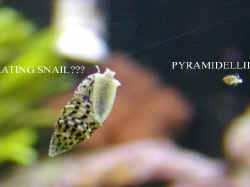
|
|
Small Fishes for a 30g'¦and a Snail ID --
03/15/09
Hey Eric, hope all is well.
<<Hello Erik'¦doing fine thanks>>
Well the angelfish is leaving today; I can't wait to watch
him or her swim a couple of laps in that new tank!
<<Excellent news'¦ While Centropyge species are
generally considered a 'small' fish, they do much better
with/require more room than a 30g display provides'¦is
comparable to the smaller Tang species (e.g. 60g+)>>
I have decided with your input of course on adding that other
pair of scarlet cleaners.
<<Okay>>
But now here is the big fish question for you! I am thinking
about adding Firefish (Nemateleotris magnifica) to my tank. But
as I have been reading around your site it seems many other
aquarists have issues keeping them alive?
<<Indeed'¦ I think there is a key aspect of this
little fish's husbandry that we hobbyists have not quite
figured out yet. Most all in my experience/observations have
simply just disappeared within a year or less (often much less).
And while considered a 'social' species that suffers when
kept alone'¦keeping more than one in a captive system of
most any size has also proven problematic>>
So here goes!! Would it be alright if I added Firefish to my
aquarium?
<<I think there are better options'¦ Perhaps one
of the smaller Cardinalfish species'¦ Maybe a trio of
Apogon cyanosoma or Sphaeramia nematoptera'¦or even
better in my opinion for your 30g display, a small group (5) of
Apogon leptacanthus>>
From what I've read it seems three are pretty much required
but I don't know how they would fair in my quarters.
<<There are some who would say this is fine 'I am
not among them. I feel certain you would only have one after a
while 'and then not even that>>
And if it is ok, would they leave my scarlet cleaners alone or,
would I have to worry about losing a sizable investment?
<<Neither the Firefish or the Cardinal species I have
mentioned are a threat to adult cleaner shrimp>>
I haven't read anything that says I should be worried about
that but... I would much rather be safe than sorry. Especially as
I have grown attached to my little cleaners!
<<Not a problem>>
Oh, I also finally took a picture of those little snails that are
"thriving" in my tank! So if you would kindly take a
look see I would really appreciate it! If you need a closer shot
or anything else don't hesitate to ask!
<<These appear very much to me to be a Pyramidellid species
(look up the genus and see what you think). If you have no clams,
and they aren't attacking any corals, they will likely wane
on their own>>
Looking forward to your advice,
Erik
<<Cheers, EricR>>
Re: Small Fishes for a 30g'¦and a Snail ID --
03/16/09
Thanks for the info about those snails!
<<Quite welcome, Erik>>
I think they are leaving my sponges alone and don't seem to
be bothering anyone...yet.
<<If not bothering anything in the tank now, they are not
likely too>>
But after I read up on them I've decided that I would rather
get rid of them now before I upgrade. I can only imagine the
hassle it would be to try it in a 300 gallon tank. Especially
since I plan on placing the same rock from my current tank into
the new one.
<<If my ID is correct, yes, you do not want to introduce
Pyramidellid snails to your new display>>
So With your approval I was wondering if adding 1 six line wrasse
to the equation would be a good idea?
<<I find this wrasse species to be more trouble than
it's worth in most cases, due to its nasty disposition
towards similarly sized and/or shaped fishes. But in this
instance, it may be worthwhile to introduce one to the 30g
tank 'let it take care of the Pyramidellids
(hopefully)'¦and then return it to the LFS before
stocking any other fishes>>
I know that they can eat small inverts but I don't plan on
adding it right away.... not until I get those other 2 shrimps
and when they are a big enough size, so that way they won't
seem so...tempting.
<< Pseudocheilinus hexataenia isn't likely to be a
problem re your cleaner shrimp, unless VERY small 'but I
have seen them attach and harass other small fishes to death on
too many occasions>>
And from what I've read the Sixline is reef safe and would
hopefully be a wonderful little addition to my aquarium.
<<This seems to be the conventional wisdom'¦ I am
inclined to disagree'¦ But as with everything else we
discuss 'do research other sources and use your own good
judgment to make a decision>>
By the way the Sixline would stay the only resident in the tank
(fish wise).
<<Ah'¦okay'¦different scenario. As the
ONLY piscine resident of the 30g, yes, I do agree it would make a
'wonderful little addition' as you say>>
Now if you don't think it's a great idea, I'll go for
those cardinals!
<<Up to you (one or the other)'¦but the Cardinals
will be of no help re the snail eradication>>
More specifically the pajamas they just seem safer as far as
aggression and invert safe. And 'they are pretty cute
lil buggers!
<<A great little fish (I have a dozen in my own reef
display)>>
Oh! I almost forgot, my scarlet shrimp (the not preggo one) is
acting a little withdrawn. He seems to not be so into eating as
much as the pregnant one, they both were voracious eaters until
today now she seems to be eating enough for the both of them. So
do you think that maybe he is preparing to molt?
<<A possibility>>
Or should I be concerned?
<<Don't know 'and even if so 'what
would you do?>>
Water parameters are all stable and pristine.
<<Then likely nothing to worry about/nothing you can
do>>
A penny for your thoughts'¦eh make it a dollar lol.
Thanks in advance!
Erik
<<Is a pleasure to share... Eric Russell>>
|
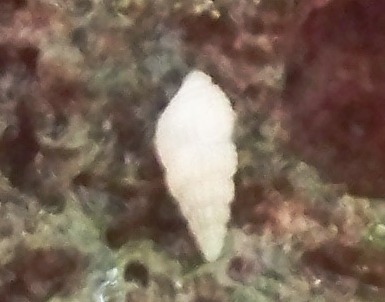 |
R2: Small Fishes for a
30g'¦and a Snail ID -- 03/17/09
Once again thanks for the prompt response.
<<Always welcome>>
I must say you all do an amazing job here and your advice is
greatly appreciated not only by your readers but also the little
guys in the tanks!
<<Thank you 'this is indeed our intent>>
I am sure the wrasse will be a great pest controller and beautiful
addition!
<<Very nice/attractive little fish (love the green
tails)'¦just so dang mean!>>
BTW the shrimp did molt he's back to normal!
<<Ah, excellent>>
Thanks again for all of your help!
<<Any time my friend>>
Best wishes!
Erik |
Astrea Snails Explosion 11/04/08
Hi WWM Crew, This is perfect timing for my problem since I do not have
a camera. You posted a question on 11/2/08 by Matthew entitled
"Astrea Snail Spawning." He sent you a great picture of all
these tiny snails. I have a 29 G reef tank and have recently had an
explosive growth of these snails. <Possible, but unlikely... there
are some hitchhiker look-alikes that reproduce more commonly.> They
are becoming a problem though. I have a chiller hooked up to my tank.
The snails have obviously crawled onto the large Rio pump that is
connected to my chiller. There are now many of these tiny snails
attached to the inside of both the intake and output tubing of my
chiller, as well as inside the tank. I am worried that they are going
to clog up my chiller! What can be done to remedy this problem? Any
suggestions will be greatly appreciated. <Please send in a picture
if you can. It would be helpful to be more sure of what we're
dealing with here.> Thanks so much. Bonnie <De nada, Sara
M.>
Re: Astrea Snails Explosion
11/05/08 Hi Sara, Thanks for your reply, but as I said,
unfortunately, I do not own a camera. <Maybe borrow one?> The
snails look "exactly" like the small snails in the picture
that Matthew sent in on 11/2/08 entitled "Astrea Snail
Spawning". <I understand this and I was not ignoring your
observation. However, a lot of the shells of these different snails
look "exactly" like each other. You simply can't ID a
snail from merely a photo of the top/side of its shell.> Sorry, but
hopefully you can try to give me some information. I sure would
appreciate it. <The best advice I can give you is to wait it out.
Even without knowing for sure what kinds of snails these are, most such
aquarium creatures don't maintain large populations for very long.
They experience "booms" and "busts." You can try
manual removal, but that would likely only delay the "bust"
as it would likely allow a smaller population to persist for longer. If
I were you, I'd just wait for the population to
"naturally" start to decline. This might take several
months.> Bonnie <Best, Sara M.>
Fighting Conch? (I'm Doubtful) -
03/09/06 Hello WWM Crew, <<Hello Glovanna>> Just a
quick question. I was needing some more algae eating snails for my 55
gal. tank. My son in law brought me several turbo snails, 1 Mexican
turbo snail, and then a few days later he came over with a Fighting
Conch snail. The LFS guy told him that it's an algae eater and safe
in a reef tank. <<True, for the most part...if this is in fact a
Fighting Conch (Strombus alatus).>> After quarantine, I added the
snail to my tank about a week ago. Almost every morning, I've found
the Fighting Conch latched onto a turbo snail. <<And the
suspicion starts to build...>> This morning he was latched onto a
bumblebee snail. I'm having a hard time believing that this
Fighting Conch is eating snails that have died. <<Me too>>
As a matter of fact, after leaving the bumblebee ( dead now for sure ),
he is now latched on to my large Mexican Turbo snail, which was not
dead earlier this morning! <<Time to ditch the conch!>> I
actually had my son in law return the Fighting Conch to the LFS a
couple of days ago, where he was told that the fighting conch would
only eat a snail after it was already dead. Then he was shown a tank
full of Turbos with 1 Fighting Conch and was told that they've
never lost a snail to the Conch in that tank. <<I'll wager
what you have is not Strombus alatus, but quite possibly is a Crown
Conch (Melongena corona ). If so, these can be quite predatory on
snails. Of course this is all speculation with a sharp close-up photo
to view.>> All I can go by is what I'm seeing this snail do
in my tank. I don't have a picture of the snail, but it is large,
probably 4 inches from tip to tip. Its shell is orange in color. Its
foot is also orange in color. I've never seen its "mouth"
like you do with Turbos when they're grazing. <<Mmm,
no...Fighting Conchs have a protruding "snout" with which
they feed...you should see this, and eye stalks, from time to
time.>> It has occasionally climbed onto the glass where a mouth
should have been able to be seen. Have you ever had any experience or
heard of this snail being a predatory snail? <<While it is a
possibility, "Fighting" conchs are not considered snail
predators. I think you have something else.>> Waiting eagerly for
your answer, so I'll know whether this is all in my head, or if he
should be removed immediately! <<Whether this is S. alatus or
not, based on your information I would remove it (for good) if you wish
to keep your snail population.>> Thank you, Glovanna
<<Quite welcome, EricR>> Heliacus areola Infestation -
01/03/06 Hello, <<Hello>> I believe I have an outbreak
of Heliacus areola snails in my reef tank, hundreds of tiny white
snails with dark radiating pattern devastating several Zoanthid
colonies. <<Mmm, trouble indeed.>> Is there any safe
natural predators that are not going to harm my leather corals, bubble
corals, mushrooms, xenia, anthelia, colt, Candycane, hermit crabs
(Calcinus sp. , red leg, blue leg), snails (Nassarius, Cerith, Astrea,
Trochus), Tridacna maxima, clown fish, cleaner shrimp? Would appreciate
any advice, struggling to save zoo's. Allan Larkins <<Well
Allan, I would begin by manually removing as many as possible...And
you'll likely need to do this a couple times a week as you'll
never quite get them all. As for a biological predator, one of the
"lined" wrasses (Genus Pseudocheilinus) may prove helpful.
But be aware these fish can be little terrors toward other fish
sometimes (opinions vary)...you'll have to weigh the risk yourself.
If the tank is large (more than 100 gallons), you might want to
consider adding two different species. I think the eight-lined wrasse,
as the largest commonly available of the species, would be your best
bet, but it is also the more aggressive. You might do better to go with
the six-line, or a six-line and a four-line, space permitting. Tis your
call. Regards, EricR>>
Quick question regarding Tridacna, pyramid
snails - 6/5/08 Good morning! At least up here in Alaska. <A
lovely one down here, too!> I have hopefully an easy question
regarding a T. Squamosa in my tank, but I suppose it applies to all of
the Tridacna species. <Okay> If this clam is bored (as in
drilled, not as in being not interested) by a small predatory snail to
the point that it actually has a small hole in it's shell... if the
snail and all others are removed, will the clam remake the shell and
the hole fill in? Or is that a permanent hole from that point on? <I
believe that with time the hole would fill in, clams add material to
the entire inside of their shells as they age. The big concern would be
entry by a errant Polychaete, or a microscopic pathogen of some
sort.> I don't have a real good grasp of how clams actually make
their shells, I would think the mantle somehow deposits the shell
material at the edge of the shell, but I've seen pictures of old
clam shells that were approaching 4 or 5 inches thick at their bases,
so it must also put shell material down even on the parts of the shell
that have already been around for quite some time. <You bet. The
mantle actually is a lot more than what sticks out over the edges, it
lines the entire shell.> Anyway, I hope that makes sense, it is one
of those things that is hard to type out in words but I could explain
easily face to face. <Understand entirely.> For what it's
worth, this situation hasn't even happened to me yet. <Glad to
hear it.> I did find a small snail on the glass last night though
and it certainly looks like a pyramid snail. I don't see any holes
in my clams and the clam is acting quite healthy, I'm just wanting
to know ahead of time what to expect, I've learned that in this
hobby it is always better to be armed with knowledge than to be armed
with hindsight. <Well said! I would recommend that you check your
clam for Pyramidellid snails along the byssus- some people recommend
this as often as six months or a year in Pyramidellid-free aquaria.
Otherwise, it sounds like your clam is healthy. Thanks for writing!
Benjamin>
Vermetid Snails, control 05/23/08
Hey guys, thanks for all the great information. I desperately need your
help on something. I'm approaching my wits end fighting a plague of
vermetid snails!? <?> Almost to the point of giving up. I've
tried Peppermint Shrimp, Copper Banded Butterfly, Wrasses, Manual
Removal, Super Glue Injections, etc. and nothing makes a noticeable
difference. Today someone opened a new door to this situation and I
need your opinion. He suggested quarantining the infested rock in a
separate tank and adding a Trigger fish to eat them off. Would this
work? Would one type be better than the other? Are there any other
non-reef safe predators that would efficiently and voraciously remove
these pests? Any input would be much appreciated! Thanks again! Will
<Mmm, myself... I'd just ignore/enjoy them... but there are a
few "Aiptasia control" chemical approaches to try that may
well work to kill the larger ones... Bob Fenner>
Re: Vermetid Snails 5/23/08
Thanks for the reply Bob. Not sure why all the question marks are at
the end of every sentence. <Me neither...?> So what chemical
approach would be effective without killing all the beneficial goodies
in the live rock? <... see WWM re... have just witnessed a new one
at Red Sea's booth here at Interzoo (in Germany), the
industry's largest trade show... that is administered via a
syringe... that somehow induces the pest organisms (in their demo.
Anemonia and Aiptasia) to "eat" then dissolve... really
neat... and evidently very "reef safe"> I did like the
snails at first but now have more than 25-30 per sq inch.?On average,
they are 1/8th to 1/4th of an inch in diameter and about an inch long.
They have completely overtaken the aquarium that I have put so much
work into over the last six years. It's to the point that the
aquarium just looks nasty. What do you think about the Triggerfish
idea? Thanks again, Will <Worth trying. Bob Fenner>
|
Pest/Predatory Snails 4/16/08 James. Hope
everything is well. Long time no talk my friend. <Ah, yes,
didn't think I was with the crew that long.> I don't
know if I am just unlucky with reef keeping or what. <Luck has
very little to do with this hobby.> My tank is two years old
now (Ahhh...has it been that long???) and I think it is healthy.
I say "I think" because I never seem to have an
absolutely fool proof tank. From day one, I have battled ich (no
fish death yet up to this point), high nitrate, imbalanced water
parameters (learned why I need to monitor magnesium too), hair
algae, and Cyano bacteria. I won in all those battles. I thought
I am home free up until now. About 1/2 month ago, I purchased a
Crocea Clam. Up to this point, it is very healthy - smooth mantle
(not pinched) with gorgeous purple, blue, and green coloration.
Has grown from 1.5" to 1.53" (using caliper to measure
accurately). It is not attached to anything yet as the clam is
still in my quarantine tank (water fed from main system then
overflows back to sump). For my question. Remember my Cerith
Snails, the ones laying eggs all over the place. Remember I
mentioned on my previous emails to you that I see small snails
creeping up at night? <Too many emails to remember individual
ones, especially that long ago.> Please look at the photos.
Are these Pyramid snails? <Pic not that detailed, but appear
to be a Cerithium of some kind.> I have had them loooong
before I had a clam. In fact my clam is not even in my main
display tank yet. From your website let me quote one of Mr.
Fenner's response (you, Bob, Anthony and the rest of the crew
should be called Drs. 'cause that's what you are guys in
my book) <Bob and Anthony may be worthy of that title but
scratch me off that list.> "If these small snails
aren't causing direct trouble, I would ignore them... there
are MANY gastropod species... Most are not predaceous. Bob
Fenner". I see 8 Cerith snail shells (now down to 22 from
previous 30) but these were taken away from them by my dwarf
hermits. I still have my aqua cultured Fighting Conch, Turbo
snails down to 4 from 12 (again I think was due to hermit
attacks). <More than likely if they are large hermits.> 8
Nerite and Nassarius snails respectively. I still have 20 hermit
crabs. 4 in main display tank while the rest is has been in my
refugium for about 7 months now. For two years, I have not added
nor removed any of the snails. Same photo. Am I seeing sundial
snails? I can't seem to find any luck with Zoanthids. <Is
because of the Sundial Snails, very predatory toward
Zoanthids.> That is why I stop keeping them trying to keep
them. For more 9 months now, I never have these corals. If they
are indeed Sundial pest snails, then what is sustaining them?
<Some of the snails in the photo are sundial snails or appear
to be and they really need Zoanthids to survive for any length of
time. I'm sure they will soon die, but if it were me, I
dispose of them before that happens. No real use in a tank other
than to control Zoanthids.> Note: Photo - snails with
maiden's hair plant for size reference. Vermetid Snails. They
seem to be not causing any harm. Was kept in check by an Emerald
crab (a hitch hiker about 2 inches wide now) and low system
excess nutrient. Initially, I thought of this crab as a gorilla
crab as I have seen it eating the v snails. When I caught the
crab, closer inspection reveals claws with blunt tip. That
together with its shape (except being brown and tan in color) led
me to believe it is an Emerald crab. It was eating coralline
algae off my LR too. Witness it myself. Anyway, since it took me
years before I finally caught it, I figure the crab can help
remove excess coralline off my refugium/ sump. It is in there
now. Mr. Calfo's book of coral propagation mentioned that
Vermetid snails is a "normal" thing. He further
reinforced that here at WetWebMedia "But I can reassure you
my friend... control the nutrients and you will control their
growth. There is no "reef safe predator" on these
snails for the aquarium. Anthony". How bad are they as other
website (sorry won't name them) seems to focus on their total
eradication? This made me think that maybe I should put the crab
back to help in controlling. Decisions...decisions...decisions.
Please help fully understand and hopefully choose the right path.
<Best to have you read here on this snail, will further
educate you.
http://reefkeeping.com/issues/2005-01/rs/index.php> Solution.
I was thinking of getting a 4-line or 6-line wrasse not just for
their beauty but also for helping me remove these pest snails.
Your thoughts here please? <The wrasse may work, Copperband
Butterflies have been known to eat them along with Hermit Crabs
but much cheaper/easier to just remove.> Reef Fish Status. I
have some really crazy fish. I have a Hippo Tang (3 1/4 inch)
that does eat veggies (ich and HLLE scars, uneven fins -
deficient but very fat), a trigger fish that prefers dried
seaweeds over flakes and frozen foods (except live brine shrimp),
and a cardinal fish that is a tank bully - chases my trigger fish
(even if the trigger fish is a bit bigger than him; about 2 3/4
inch long). I smile every time the cardinal fish tries to chase
my Red Tooth Odonus Trigger; tries to run after him for just a
couple of inches and then stop and hovers back again. The
cardinal fish actually tries to bully everyone that crosses his
path. Already talked to my LFS in trading these fishes for some
corals and a 4-line or 6-line Wrasse as he witness my reef fishes
and finds them intriguing - funny he sold me those fishes :) pH -
8.3 to 8.4 (controlled by Neptune AquaController) Ammonia and
Nitrite - absolutely 0 Nitrate - 5 to 10 ppm Phosphate - low 1
ppm (red sea); 0.3 ppm water sample tested locally yesterday CA -
425 (Calc Reactor) Alkalinity - 9 dKH Mg - 1350 ppm <Jon, as
Bob mentioned, most snails are harmless and is best to keep an
eye out for would be predators/pest snails and remove. Good to
hear from you again. James (Salty Dog).> Sincerely,
Jon Glorioso
|
|
 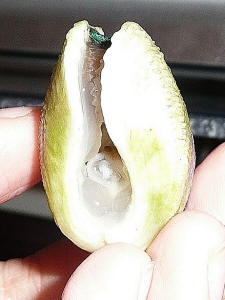 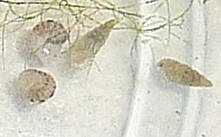
|
Pyramid snails on Cerith Snails? 04/14/2008 Hello
Guys, <Howzit?> I have a very successful, although unintentional,
breeding program for Cerith snails in my aquarium. For the last couple
of weeks I have seen another variety of snail riding along on many of
them. They are small white snails that meet the description of a
Pyramid snail, and sometimes a Cerith will be carting around two or
three of them attached to the front portion of its shell. I have
Zoanthids and a clam that are all untouched and in perfect health, no
snails present. None of my corals have been touched in the least from
what I can see so far. I also breed Checkerboard Nerites and they are
not bothered by them. I understand that Pyramid snails are specific
feeders, but are they this specific? Is it possible I am seeing
something other than Pyramid snails? <Oh yes, of a certainty> I
am not noticing an increase in snail deaths in my aquarium at this
time, as judged by an increase in empty shells, but I have a couple of
hundred Ceriths so a small change would be difficult to detect.
It's hard to tell an occupied shell from an unoccupied one when
there are so many of them. If these do turn out to be Pyramid Snails
that are specific to my Cerith snails is there any way to get rid of
them without harming the Ceriths? <Mmm, not easily... but some small
snail-eating fishes (e.g. wrasses, see WWM re) might reduce and keep
small snail numbers down...> Hand removal is impossible, there are
far too many of them. Never mind, I already know the answer to that
question :) I have a 6-line wrasse, and maybe he is picking them off
the clam but can't get to the ones on the Ceriths, since they are
primarily active after dark when the wrasse is asleep? <Maybe...>
I have seen these snails climb the glass on occasion, but it's not
where I would look for them first if I wanted to find one. If a picture
is important to you it would be easy to obtain one, if I knew how to
use the macro on my camera. I will figure it out if need be though,
don't hesitate to ask. Thanks in advance, Barbra <If these small
snails aren't causing direct trouble, I would ignore them... there
are MANY gastropod species... Most are not predaceous. Bob
Fenner>
Vermetid Snails -03/17/08 Hi Crew, A few months
ago I wrote in for suggestions on how to stop the Vermetid snail
explosion that was consuming my 6 year old, 75 gal tank. As suggested,
I tried peppermint shrimp, arrow crabs, a copper banded butterfly, and
even manual removal and nothing has worked. <Hmm... none of those
things reliably eat these critters.> There's just too many.
I'm almost at the breaking point. There's so many of them(5-15
per sq inch) that they are starving my corals with their 'webs'
and making my tank look really, really ugly. Are there any other
alternatives to get rid of these pests? I'd hate to start over and
lose the last 6 years of hard work. Thanks so much for your help!
<What did you try for manual removal? You might try spraying them
with a little vinegar, Kalk solution or even NaOH if you dare. I do
believe they will eventually go away/die down. But it may be awhile
before that happens, unfortunately.> Will <Best, Sara M.>
Sundial snail babies? Hopefully harmless Collonista
snails! 3/3/08 <Hi there.> I recently found a few sundial
snails in my tank. <Yikes, hopefully not dining on your prized
Zoanthids! Do you keep Zoanthids or were these just incidental
hitchhikers? Sundials only eat Palythoa and Zoanthids, so unless you
have those, they'll simply die out. If you do have/keep Zo's,
definitely remove any Sundials you see.> I now have many tiny, tiny
snails I think could be their babies. Are there any natural predators
for these snails? <I don't know of any that prey exclusively on
Heliacus/Sundials, but I'm sure there are other predators that
include them in their diet. Unfortunately, it's always possible
that the predator(s) could have a taste for more than just Sundials (as
in other beneficial invertebrates)! Complicating matters is the fact
that Heliacus are mostly nocturnal. They're able to hide very
effectively within Zoanthid colonies during the day when snail eating
fishes are active. Regarding those tiny snails, there's a chance
that they might not be juvenile Sundials. There's another very
common snail in the genus Collonista (aka 'mini Turbos') that
has a similar appearance, but is a harmless herbivore/grazer.
They're mostly nocturnal, reproduce readily, and stay small
(usually around 3mm). Color/pattern varies, with some being all white,
while others are combinations of white with varying amounts of mottled
tan/brown/even pink markings. A sure fire way to differentiate Heliacus
from Collonista is to grab a magnifying glass and take a close look at
the operculums (the 'trap door' at the opening of a snail).
Heliacus have conical/pagoda shaped operculums while Collonista's
are relatively flat with a characteristic pit in the center. Basically,
if it's pointed, it's a Sundial. If not, it's likely a
harmless Collonista. I'm hoping that you have the latter! Please
see the following links for comparison/more information:
http://www.wetwebmedia.com/snailidf14.htm (Collonista snails)
http://reefkeeping.com/issues/2004-05/rs/index.php (Collonista -
operculum shown) http://www.wetwebmedia.com/snailidf13.htm (Heliacus -
see pointed operculum in photos about halfway down the page) I've
got my fingers crossed for you! Take care, -Lynn>
| Snail eating coral? Possibly. Remove? Definitely!
2/3/08 Hello Crew, <Hi there!> I recently purchased an
order of hard/ soft corals from GARF and have found two snails on
what I believe to be Seriatopora guttatus or Stylophora pistillata.
<Uh oh.> I broke the snails free and the coral was completely
bleached underneath. <Ouch!> I'm assuming that this is
just because they stayed there for such a long time. <Could
be.> There is no trail of bleaching leading me to think that the
snail is feeding on the coral, but I have never seen a type of
snail that stays on a coral so long as to bleach it. Any input?
<Yep, any snail that damages a coral like that has to go! After
looking at the photos, I can tell you that it's not Drupella
cornus, a snail species with a taste for the two corals you
mentioned, plus others. Unfortunately, there are many other
coral-eating snails, and I can't quite see enough detail in the
photos to tell if yours is one of them. As mentioned before,
I'd go the safe route and get rid of them.> And one more
semi-related question, when do you decide that a bleached coral
(Acropora sp.) no longer has a fighting chance? Take care.
--Lynn> |
|
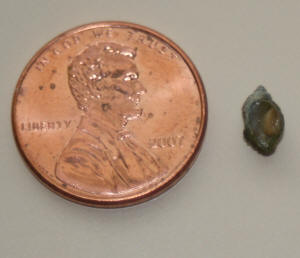 .JPG)
|
Snail ID/James' Input 1/6/08 Hi Bob/crew,
<Hi Sara> One of my friends is asking me about this snail he
found in his tank. It definitely looks like a whelk or murex of
some sort, but I wish I could narrow it down more than that for
him. The body coloration is not like that of any other snail
I've seen in an aquarium before (not that that means much).
<Sara, this looks more like a Tulip Snail to me, no expert
though. If so, they are predatory, will feed on Astrea, Turbo, and
other snails.> Thanks,
<You're welcome. James (Salty Dog)>
Sara-- |
|
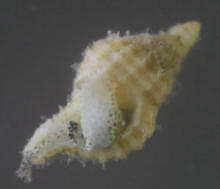
Snail ID/Lynn's Input - 1/6/08 Hi
Bob/crew, <Hi Sara> One of my friends is asking me
about this snail he found in his tank. It definitely looks
like a whelk or murex of some sort, but I wish I could narrow
it down more than that for him. <I'm in agreement with
you and James. It does look like something in the Buccinoidea
(Whelks, Tulip Snails, etc), or Muricoidea (Murex)
superfamilies. I haven't found an exact match, but I do
have some candidates that are similar. Unfortunately,
that's about as close as I can get without a super clear
photo of the shell front and back, or knowing where this
little guy is from. Here you go:
http://www.conchology.be/en/availableshells/shellsforsaledetails.php?uniquenumber=164124#f
http://www.conchology.be/en/availableshells/shellsforsaledetails.php?uniquenumber=201755#f
http://www.gastropods.com/5/Shell_7095.html
http://www.conchology.be/en/availableshells/shellsforsaledetails.php?uniquenumber=370154#f
.> The body coloration is not like that of any other snail
I've seen in an aquarium before (not that that means
much). <I have some photos of a Whelk hitchhiker from my
tank (Cantharus tinctus) with similar tissue
coloration/markings (may provide a clue):
http://wetwebfotos.com/usermedia/high/0/2470_50.jpg The focus
could be a lot better on the tissue here, but you get the
idea: http://wetwebfotos.com/usermedia/high/0/2470_51.jpg
.> Thanks,
<You're very welcome! -Lynn> |
|

|
|
|
That's no Nassarius! That's a predatory
Olive snail! -- 12/24/07 Hey WWM crew. <Hi there.> I
have been reading lots about identification of snails, and have
identified the snails that have been trolling my tank as cap
snails. <Neat. Stomatellids are terrific little grazers that
make a nice addition to a tank.> Also have been reading on
some other snails people have encountered and found this one
interesting. Attached below. I also bought 4 of these snails at
one time (sold as Nas) <Ugh -- don't even get me
started!> and watched them eat one of my Astrea snails.
<Yep, what a shame. These Olive snails are beautiful, but are
predators/scavengers, and look nothing remotely like a Nassarius.
How they can be sold as such is beyond me.> After hours of
searching I found out what it was. I got rid of them right away.
<Understandable -- hopefully you educated the seller!> Just
saw a few people had questions and that you guys were unsure of
the identification. Lettered Olive Snail Oliva sayana <Much
appreciated! Here's another photo of one, as well: Take care
-Lynn>
|
|
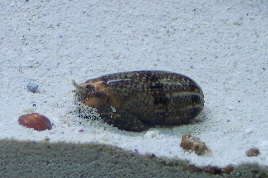
|
Mr. limpet and the Pyramids -12/15/2007 Hello
crew, I try to avoid asking questions and believe I have only asked 2
so far. Usually I can find all my answers with research on your site
and or others. This one seems to allude me though. I have been running
a 55g reef for 2 years now. The last year has been really great. Anyway
this question doesn't really pertain to lighting or water
parameters so I will skip that this time. I was doing some research on
clams because some day I would like to own one. I then stumbled across
something called Pyramidellid snails. To my amazement I have recently
noticed these little guys before. They were on my turbo snails!! After
I found out what they were I promptly brushed them off of my snails and
waited for dark. ("the freaks come out at night") Here they
were by the hundreds! Now at this point according to my calculations
manual removal of such little creatures would take somewhere between
100 to 1,000,000 years. I also have hundreds of limpets that don't
seem to bother anything in my tank including the Montipora. Now here it
is, will the pyramidella's feed off of the limpets? Therefore
removing the snails for a long period off time to remove the
pyramidella's food source thus starving them to death would not
work, correct? I also cannot use a six line wrasse or other type to
help control nor do I think a wrasse would work effectively anyway. Any
Ideas? <Well, first things first... please make sure you have the
"bad guys" before you start to worry (or start killing them
en mass). There are several harmless/beneficial snails which look very
similar. Please see here:
http://www.reefland.com/rho/2006/05/identify_rissoid_pyramidellid_snails.php>
I apologize for the incomplete e-mail. <no worries> Any help on
this subject would be greatly appreciated. Thanks, Nick <De nada,
Sara M.>
|
Snail Id's: Babylon and possible Limpet -
12/6/07 Hi Crew, <Hi Russ> Great site you've got
going on here, <On behalf of Bob and everyone here, I thank
you!> and, as you people seem to be the font of all marine
knowledge, I'm here to ask a couple of (hopefully not too
dumb) questions about some snails I've got. <Heee, no
worries there my friend - ask away!> First up, I bought some
Astreas from the LFS the other day (they were sold as Turbos, but
as they can't self right, I'm guessing I have been had),
and a couple of 'Nassarius'. <Unfortunate. The
incorrect labeling was most likely unintentional, but it serves
as a reminder for all of us to confirm exactly what we're
getting before bringing it home. Thankfully, most stores offer a
selection of books that can aid in this. If they don't, and
you're the least bit unsure, don't buy. LOL Just step
away from that tank! The best thing to do is go home, figure out
what it is and whether you can provide for its needs. Just doing
this one thing could save many, many, lives, and so much
frustration! Okay, I'm stepping off my soap box -- for now,
anyway! ;-)> One of the Astreas had a 'growth' on its
shell, which I noticed was moving, so I pulled it off to discover
it was a snail of some sort, and was wondering if you could ID it
- the photos show it in situ on the snail, and then on the glass.
Its got a real odd shaped shell. <<snail1.jpg>> >
> <<snail2.jpg>> <Unfortunately, I can't
see the shell well enough to Id. My first thought was that it
might be a Nerite, but the shot taken from underneath indicates
otherwise. The margin shouldn't be sharp like that all the
way around. One end of the shell should be curled/extending
underneath. Without additional photos (top view and any view that
would show whorls/lack of, etc), I'm going to guess that
it's a species of limpet. Not all have the classically
pointed cone shape.> Secondly, I'd like to ask if you
could ID what I believed to be Nassarius <Is similar, but not
in same genus.> - they are beautiful <Indeed!> but I
can't find a reference to anything like them on the web. They
do live under the substrate and show only their siphon, but it
seems they may be a bit on the large side for Nassarius vibex -
any ideas would be gratefully accepted. <The color pattern,
and the deep suture along the whorl, give it away. Its common
name is a Babylon shell (genus Babylonia), and depending on where
you look, is either in the family Babyloniidae or the family
Buccinidae. Taxonomic flux/synonyms drive me nuts! I won't
even go into it here because it would take up way too much space,
but suffice it to say that this little guy is grouped in with
whelks (predatory/scavenging snails) and I wouldn't trust it.
Please see these links for comparison/related info:
http://www.gastropods.com/Taxon_pages/TN_Family_BABYLONIIDAE.html
http://www.reefkeeping.com/issues/2005-11/rs/index.php > What
would you recommend in terms of keeping or returning these?>
> <<snail3.jpg>> <Need to know what other
inhabitants are in the tank/conditions therein. If you have a
full blown, mature, reef tank, the Astreas should be okay with
enough available food (just keep an eye on them). As for the
limpet (tentative Id), it could go either way. Some are
harmless/innocuous grazers, while others are capable of putting a
serious dent in your coralline, or even your corals! Not too long
ago, I caught one on my favorite Blastomussa wellsi! Last, but
not least, the Babylonia spp. Of the three snails, this would be
my biggest concern. Not only, because of its possible predatory
nature, but because I can't find any information on its
needs. For example, it might not even be suitable for the warmer
temperatures of our reef tanks. It's not unusual to see
snails sold online/locally that are from more temperate regions.
Snails such as this live an accelerated life - surviving for a
brief period, then dying. Hopefully, that is not the case here,
but I honestly don't know. I think it comes down to what
Dirty Harry said: 'Are you feeling lucky?'. Personally, I
don't like the odds. That snail would have to go!> Many
thanks for your help <You're very welcome.> Russ
(Sheffield, UK) - resent with capitalized 'I's :-)
<Much appreciated :-) Take care -Lynn (Seattle, USA)
|
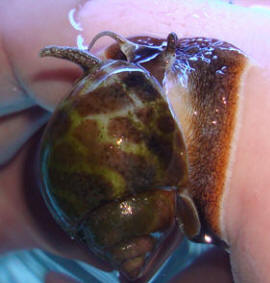 .jpg) |
|
.jpg)
|
|
ID help for others... Sundial snail (Heliacus
sp.) 11/25/2007 Hi Crew, Chris here again. <Hi Chris, Mich
with you tonight.> I believe I have ID'ed this as a
sundial snail from what I've seen on the ID pages. <Does
look to be so, but the pagoda shaped operculum (trap door) would
really confirm this as a Sundial snail (Heliacus sp.)> I just
wanted to send these pictures to help others as I did not find
any pictures as clear as these anywhere in the FAQ pages.
<Thank you for sharing. Always appreciated. Mich>
Re: ID help for others... Sundial snail
(Heliacus sp.) 11/25/2007 I was thinking that the picture
attached showed the pagoda trap door. <You are correct. This
picture shows the white pagoda/cone shaped trap door (operculum)
quite well.> If not please let me know. <No, you are right.
I see you included this pic in your first email, but somehow I
only saw the other image. My apologies.> I'm trying to
learn as much as possible about as much as possible as fast as
possible. <You Cheers,
Mich>
|
|
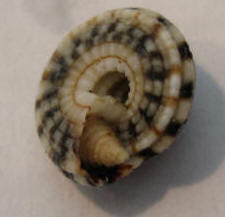 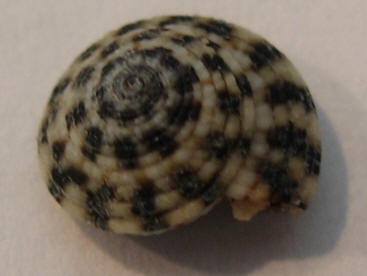
|
Pyramid snails....what pests! 10/29/07 Good
evening, Longer time reader (3yrs I think now). Probably find 99% of
all the info I need in this hobby on this site. great job. Tonight I am
not sure if I have done enough reading as it's after 1am and
I'm barely able to type and keep my eyes open. Here's the
situation: I have a 11-12 inch squamosa clam sitting on the bottom of
my tank. I have had it for over a year. It has grown a lot in my tank.
Well tonight I was admiring my tank just before the lights went off. At
the exact time my day lights shut down, my clam got startled and closed
quickly....at that moment I noticed 3 little white snails under one of
the mantles. Clam looks awesome and healthy...never seen these snails
before. <This isn't uncommon. Usually the snails reach large
populations before they start to hurt the clams they feed on.> So
now I start obsessing....of course. I get a flash light and start
looking around the clam. It closes up more and I see dozens of the
little snails. I do some research and learn they are pyramid snails.
Wow...this hobby is nuts. Always something. The clam is attached to a
flat piece of rock so I decide to take the entire rock and clam out of
the tank to brush the snails and eggs off it. OK....there may have been
at several hundred on the clam. None on his foot. Crazy thing...my clam
looks great. <quite typical> I also have 1 deresa and 3
crocea's as well. I check each of those and it only gets worse. All
but one of them had the little pests as well. 3 of the four have no
feet (whatever it's called that connects them to the rock)!!
<Ah, good news! Those filaments that connect the clams to the rock
are not actually its foot, they're called "byssus
threads." Funny thing is, I didn't know this either when I
first accidentally pulled one of my crocea clams off a rock and ripped
the byssus threads. I was so upset I started crying like a baby
thinking I'd killed my clam by ripping off it's foot. But the
foot is something else entirely (and yes if they lose that, they're
probably doomed). Fortunately, unlike the foot, clams can regrow byssus
threads fairly easily. That clam of mine is still happy and healthy and
fully reattached to its rock. :-)> Question...are they doomed? No
feet = death? Do the feet grow back? They are open but...? <As
explained above, no feet usually does = death, but it's not
actually the foot that attaches these clams to a base.> How do I get
them out of my tank? I have a six line wrasse but obviously he sucks...
<lol, I think a Hoeven's wrasse (or maybe a green wrasse?) might
be more effective if you want to risk it. Do keep manually removing
them. Please see here: http://www.wetwebmedia.com/pestsnailfaqs.htm If
the clams are otherwise healthy, your regular manual removal (and maybe
a little help from the right wrasse) could save your clams.> After I
put the clams back I saw several on the floor. I placed all the clams
off the sand hoping the snails wouldn't find the clams and just
die. <Haha, don't count on it. You might want to quarantine the
clams and just keep removing the snails and eggs manually (scrub the
clams' shells with a toothbrush) until you don't see them
anymore. Don't try any chemicals though. I imagine that anything
that would kill the snails could hurt your clams too.> Any
hope/help? <I definitely think there is hope. A few of these snails
usually aren't a problem. However, you seem to have a true
infestation that could hurt your clams. But please don't get too
discouraged yet. I do think you can get control of this.> Good
night. David W. Boswell, II, E.A. <G'night. :-) Sara M.>
Re: pyramid snails....what pests! 10/29/07 Thank
you for your prompt response. OK, great. I removed all the calms again
tonight and good news was I only found 8 snails on all the clams
combined. A huge decrease from the hundreds I found last night. I
figure I'm going to remove and scrub them every other day for a
month and then start examining one a month. <Sounds like a good
plan.> One more question....can clams be out of water? When I
purchased them the LFS pulled them out of the water and directly bagged
them. I thought I heard they should not be lifted out and exposed to
the air. <You might be thinking of sponges. A lot of sponges will
die if any part of them is exposed to air. Clams and corals are quite
different though since they can close up/retract. Some from very
shallow waters are even used to being exposed to air during low tides.
In any case, if you need to take a clam or coral out of the water for
any reason, you should "scare" it until it closes up as much
as possible. With clams, it's best if they are completely shut
tight (or very nearly so) before you take them out of the water.>
What are the dangers? The squamosa is so big it is difficult to place a
huge pot in the tank and lift it out. My tank is 30 inches deep. Also
to scrub its shell is tough because of its size. I need to roll it over
and it is quickly exposed to air. <See above. If the coral/clam is
not retracted/shut when it is pulled out of the water, it could suffer
tissue damage. So just take it slow if you have to, but make sure
it's closed when you pull it out.> Plus, I dump the pot with the
tank water after the scrubbing session and it would be easier to lift
the clam out and place back in the tank from the pot and not risk
infesting the tank with any eggs that could be in the pot. Wowo...what
a run on sentence.<lol> I think you get the idea. <Yes, and
since it's Halloween time, I think you should dress up as a vampire
and jump out in front of your clam and say "boo!" Might
work... ;-)> As for the other clams...they are small enough that I
put them in a Tupperware dish deep enough to cover them with water and
lined the bottom with sand. Each scrubbing session I can just lift the
dish out with them in it. Quarantining the clams is out because my
quarantine tank has no lighting. I usually only place new fish in there
for 6 weeks. Maybe I need to research quarantining everything I add.
<Anthony says you should quarantine "everything wet." And
that is the most prudent way to be. Quarantining corals/clams is really
not much different than quarantining fish except that you'll need
to keep the salinity at normal levels and some medications for fish (if
you use them) you can't use on corals. Here's a nice article on
the decision:
http://www.wetwebmedia.com/ca/volume_3/cav3i4/quarantine/Quarantine.htm
and for quarantining inverts:
http://www.wetwebmedia.com/quarinverts.htm> Thanks
again....G'night David W. Boswell, II, E.A. <De nada, Sara
M.>
| New little snail's ID needed... Possibly
Heliacus snails -- 08/31/07 <Greetings, Mich here.> I
have see a bunch of what I thought were baby snails. After 3 days
of reading your site and doing Google searches I'm beginning to
worry that they may be Heliacus areola. <Sure do look like it
I'm afraid, could be something else. Heliacus snails have a
small pagoda shaped operculum (trap door). You will need to check
for this as there is not this much detail in the photos.> I
would be internally <Externally too? Heehee!> grateful if you
could give me a positive ID. The first picture is from top it is
about 1/4" in size. The second picture is from under side. I
will include links to 2 short video's 50sec each. In hopes that
you can get a better view. If you think they are Heliacus areola
would you please tell me how to rid my little 10 gal tank of them.
<In my world there are picker and non-pickers... hopefully you
are a picker if Heliacus is indeed what you have. Manual removal is
about the only option in this size tank... But at least it's
only a ten gallon tank!> My Zoo's seem fine. And these
snail's stay out all day and seem to be feeding on algae on the
tank glass and rocks. <Mmm, may not be Heliacus sp., as these
are typically nocturnal.> I know there are 8 but with the
magnifying glass it looks like I have 100+ or these things.
<Yikes!> If they are good snails I should be able to get some
of my money back from my LFS. <Yeaah... Good luck with that!
Mich>
http://s200.photobucket.com/albums/aa92/emccullough1/?action=view¤t=810aed0e.flv
http://s200.photobucket.com/albums/aa92/emccullough1/?action=view¤t=6ccd02a0.flv |
|
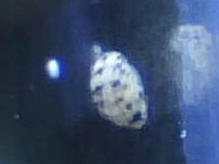
|
| Snail ID, Whelk - 4/13/07 Hello again <Hi
there!> I have a snail which I cannot identify from reading on
your site. This snail is about 3/4 of an inch long, black and
white. <Pretty!> He mysteriously appeared, I am assuming out
of my live rock, last week. I put him in a floating container, to
be able to photograph him later. Well, he just up and crawled right
out of there. <The nerve!> Saw him again today, so I took a
few photos, two of which I am attaching. <Thanks, that makes a
world of difference when it comes to these Id puzzles!> He is
very pretty, but I am not sure if he is a predator. <Yep, he
is!> I am leaning toward that he is because of his bright
markings and daytime prowling. Have put him into a container which
now has a lid with small holes. Any help would be appreciated.
<Well, I'm not sure where your rock is from but I'm
guessing it's from the Pacific, western Pacific that is. After
looking around a bit I think you may well have a species of Engina,
possibly Engina zonalis(?): http://www.gastropods.com/4/Shell_3214.html http://shell.kwansei.ac.jp/~shell/pic_book/data37/r003656.html
Here's another link with good photos of snails in this
subfamily (Pisaniinae). There are several that look similar to
yours: http://www.gastropods.com/Taxon_pages/TN_Family_BUCCINIDAE_PISANIINAE.html
If this is what you have (or one in this family), these snails are
in the Buccinidae family, commonly called Whelks. Whelks are
scavengers and predators, and if that were my snail, he
wouldn't be going back in the tank! Please read here for more
info on these interesting, if not reef friendly snails: http://www.reefkeeping.com/issues/2005-11/rs/index.php>
Thank you Dietmar <You're very welcome, is was my pleasure!
--Lynn> |
|
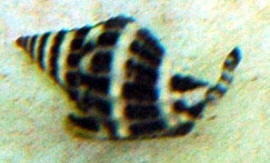
|
Tridacna parasite, Pyramidellids 3/6/07 How long
will a Tridacna clam last with pyramid snails present? <Depends on
several factors; overall health of the clam; size of the clam; level of
infiltration...what's important is getting rid of them.> Mike
<Adam J.>
| Snail ID: Possibly Sundial snail (Heliacus sp.)
3/3/07 Good Afternoon, <Good Morning I guess! Mich here.>
While having coffee this morning I observed a moving speck, which
turns out to be a snail. <What good eye you must have!> At
present my aquarium houses two Astraea and three Turbos. Also there
have been no recent additions in the last three months to account
for recent hitchhiking. The shell on which the snail is perched is
app. 1"x1 1/2" to give some idea of scale. Thanks in
advance for any information, <Hmm, Is a bit small, but does look
an awful lot like a Heliacus snail, which are predatory on
Zoanthids and typically nocturnal. Do you have any Zoanthids in
your system that are experiencing any difficulty? See this page,
next to the penny: http://www.wetwebmedia.com/polypdisfaqs.htm Heliacus
snails have a small pagoda shaped operculum (trap door) this may
help with identification. Hopefully is not a Sundial snail
(Heliacus sp.)! -Mich> Jane |
|
Re: snail id: Possibly Sundial snail (Heliacus sp.)
3/4/07 Mich and crew, <Hi Jane! Mich with you again.>
Thank you for the link to the image--the wee bugger in my tank
bears a striking resemblance to the Heliacus. <Not good.>
Unfortunately, due to its small size and my lack of x-ray vision,
the operculum was/is too small to see. <Magnifying glass?>
Difficulty with Zoanthids is now past tense--little left but a
rock and red stubs. <Uh oh!> But, thanks to you, I can see
the light--now if I can only see the snail(s) again...
<Hee!> Regards to all, <And to Jane
|
|
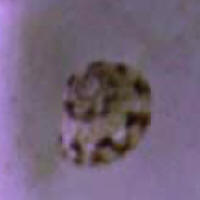
|
| Halichoeres melanurus and Pyramidellid snails
11/15/06 Hello crew, <Brandon> I have recently noticed
that there are many Pyramidellid looking snails attached to the
bottoms of my Astrea snails. <Sure looks like it> I've
been thinking of getting a clam once I decide on type and find one
I am content with but this is an obvious setback in the plan.
<Oh yes> I saw where a Halichoeres melanurus (Hoeven's
wrasse) was recommended to consume these pests but have looked at
some sites that say it is not a reef safe fish. <Is toward that
end of the scale... I'd say/state "largely
reef-safe"... how 'bout that?> What is your experience
with the fish in the reef setting? There's also a picture
attached that I took a few minutes ago. Thank you and have an
excellent day. Brandon <The smaller Halichoeres species
(there's a bunch!) are relatively peaceful, non-injurious to
cnidarians, other sessile invertebrates too small to be eaten
whole. Bob Fenner> |
|
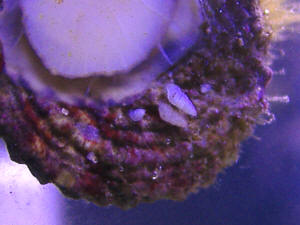
|
|
|

